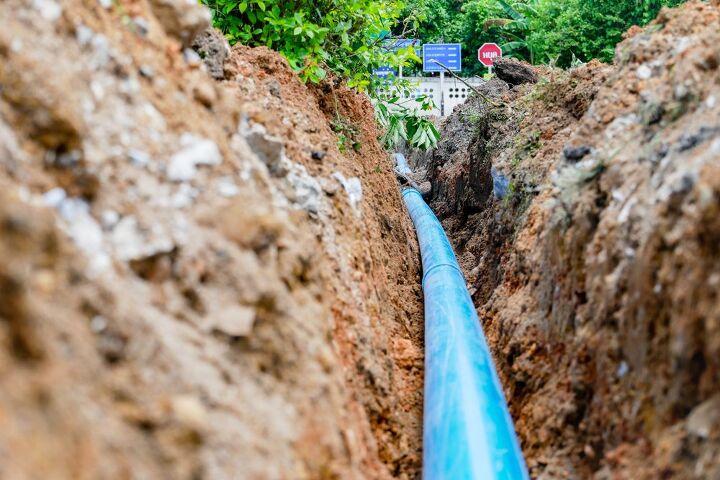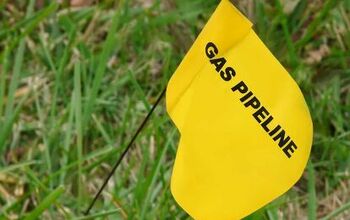How Deep Should A Water Line Be Buried? (Find Out Now!)

It is essential to bury a water line so that it doesn’t freeze or burst. However, burial depth isn’t always obvious and the last thing you want to do is damage gas or electrical lines. So, how deep should a water line be buried?
A water line should be buried 4-6 below the lowest depth of frost in the ground so that it doesn’t freeze and burst. The lowest frost point varies based on your climate and the quality of your soil. Call 811 to make sure that there are no cables, wires, or sewer lines in the ground so that you don’t damage them when you bury a water line.
Frost lines vary between states, and it is 5” in California and 58” in Iowa, for example. Check to find out the ideal burial depth in your state so that your water lines don’t freeze or suffer damage. Follow along as we explore the important question; how deep should a water line be buried?
Do You Need to Hire a Plumber?
Get free, zero-commitment quotes from pro contractors near you.

Why Do Water Lines Have to Be Buried at a Certain Depth?
There are two main reasons why water lines need to be buried. Both of them are related to protecting the water lines themselves.
First off, water lines must be buried so they don’t get damaged constantly. Exposed water lines are more susceptible to wear and tear. They may also sustain damage accidentally if you’re doing some yard work. It definitely makes more sense to bury the water lines from that perspective. Doing so is better for the pipes and for your safety as well.
The other reason why you should bury water lines is to stop them from freezing over. Water lines will freeze in a matter of hours if they stay at a temperature of 20 degrees Fahrenheit or below. Placing them underground can stop that from happening.
How Deep Should a Water Line be Buried?
You should bury a water line below the frost depth line so that it doesn’t freeze in extremely cold temperatures. Install your water line 4-6 feet below the lowest point where frost can affect the ground. It varies based on where you live, the quality of the soil, and the frost depth where you live.
However, you can only dig a hole to install a water line if there is nothing in the way. There are sewer, gas, and electrical lines that start 12” deep, and you cannot bury a water line over them or too close to them. You can knock out your neighbor’s wi-fi or damage electrical cables if you don’t check to make sure that there is nothing in the way.
Always call 811 if you plan to dig a hole that is deeper than 12” to ensure you don’t hit a gas or electrical line. You risk damaging cables and wires that can also potentially harm you anytime you dig below 12” deep. It is important to call 811 to find out if there is anything in the way that would prevent you from burying a water line.
Burial Depth for Supply Lines
It is more complicated to bury supply lines than sprinkler lines because the guidelines are different. Each state has a different frost line, and they vary widely from shallow to several feet deep. Frost lines are primarily determined based on the climate in the area, so states with warm weather or mild winters typically have frost lines below 12”.
Take a look at the data below that highlights the frost lines for all 50 states. The details included come courtesy of World Population Review. Your homeowner’s association may have rules regarding how deep water supply lines must be buried.
| State | Frost Line (In Inches) |
| Alabama | 6 |
| Alaska | 100 |
| Arizona | 10 |
| Arkansas | 14 |
| California | 5 |
| Colorado | 44 |
| Connecticut | 36 |
| Delaware | 32 |
| Florida | 0 |
| Georgia | 5 |
| Hawaii | 0 |
| Idaho | 31 |
| Illinois | 36 |
| Indiana | 36 |
| Iowa | 58 |
| Kansas | 32 |
| Kentucky | 15 |
| Louisiana | 4 |
| Maine | 74 |
| Maryland | 30 |
| Massachusetts | 32 |
| Michigan | 42 |
| Minnesota | 80 |
| Mississippi | 8 |
| Missouri | 33 |
| Montana | 61 |
| Nebraska | 48 |
| Nevada | 23 |
| New Hampshire | 60 |
| New Jersey | 36 |
| New Mexico | 18 |
| New York | 50 |
| North Carolina | 10 |
| North Dakota | 75 |
| Ohio | 32 |
| Oklahoma | 20 |
| Oregon | 18 |
| Pennsylvania | 44 |
| Rhode Island | 38 |
| South Carolina | 4 |
| South Dakota | 64 |
| Tennessee | 12 |
| Texas | 10 |
| Utah | 30 |
| Vermont | 60 |
| Virginia | 18 |
| Washington | 24 |
| West Virginia | 32 |
| Wisconsin | 65 |
| Wyoming | 56 |
Burial Depth for Sprinkler Lines
Sprinkler lines are easier to bury underground because you don’t have to worry about freezing. A homeowner can simply drain their sprinkler line when it gets cold so that it doesn’t freeze. As long as you drain the sprinkler lines completely, they should remain intact through the winter.
You can typically bury sprinkler lines 8-9 inches deep and they won’t get damaged. This depth also makes it easy to repair or maintain your sprinkler line if there is a problem.
Burying your sprinkler lines about eight to nine inches into the ground should be enough. They will be protected well at that depth and you can still get to them easily if a replacement becomes necessary.
Who Can You Ask about the Right Burial Depth for Water Lines?
Identifying the frost line for your specific neighborhood can be a bit tricky. Even if you know what the frost line is for the state, it may still differ for your property.
It’s best to be absolutely sure about the frost line before you start digging. The last thing you want is to set the pipes in place only to find out later that they’re too shallow.
To find out the frost line for your property, you can talk to your neighbors. They should know about the frost line especially if they’ve been in the area for a long time. If your neighbor doesn’t know, you can call a plumber in the area. You can definitely expect an answer for them.
Another option is to contact 811. 811 is the number to call before you initiate any type of deep digging on your property. You can also head over to 811’s website if you need assistance. After contacting 811, they will ask you to supply some information. They will ask you where you’re planning to dig along with some identifying landmarks. They will also inquire about the reason behind your digging project.
Make sure that you contact 811 at least a few days before you plan to start digging. Representatives for the relevant utility companies still need to visit your property and note where their lines are buried. It may take them a few days to show up so it’s best to call well in advance.
Both homeowners and contractors can contact 811. If you’re busy, you can ask your contractor to handle this part of the project.
What Type of Pipe Should You Use for Your Water Supply Lines?
The type of pipe you use for your water supply lines can greatly affect the quality of your plumbing for years. You need to think carefully about which type of pipe to install.
Listed below are some of the different types of pipes that are used as supply lines. Check them out to see which one will be best for your home.
Brass
A lot of homeowners like brass pipes because they are very durable. They do not rust over and friction loss is also not an issue with them. Brass pipes even excel at transporting hot water.
However, there is a chance that some brass pipes still have trace amounts of lead. You obviously don’t want lead anywhere near your water supply. Talk to plumbers about which brass pipes to use if you’re interested in them.
Cast Iron
There was a time not too long ago when cast iron pipes were the top choice for water supply lines. Considering how sturdy they are and how well they handle heat, you can easily understand the appeal.
So, why did cast iron pipes fall out favor? The simple answer is rust.
Rusting over is a serious concern with cast iron pipes. They need to be checked regularly to ensure that rust particles do not contaminate your water. Many homeowners didn’t find cast iron pipes to be worth that trouble so they went with other options.
Copper
Copper pipes work great if you need water supply lines. Those pipes can last for several decades without leaking and they also inhibit the growth of bacteria. Copper pipes also have no trouble dealing with very hot or very cold water.
Acidic water can be an issue for copper pipes, but that can be resolved easily. The real drawback to installing copper pipes is cost. You must be willing to make a significant investment if you want copper supply lines connected to your home.
PVC
Polyvinyl chloride or PVC pipes have gained a considerable amount of popularity among homeowners. Their durability is a big reason why they are so appealing. It also helps that they are affordable and easy to install.
Avoid using PVC pipes to transfer hot water though. The hot water can cause the PVC pipes to warp and your plumbing system will suffer as a result.
Do You Need to Hire a Plumber?
Get free, zero-commitment quotes from pro contractors near you.

Related Questions
Can You Put Water Supply Lines in the Same Trench Together with Electric Lines?
You may not have a lot of available space for trenches on your property. Because of that, you’re considering putting the water lines and other utilities in the same trench. You may be specifically thinking of putting the water and electric lines together.But would that even be allowed? The answer is yes. However, you do need to keep them apart by some distance.Water and electric lines must be kept at least 12 inches apart. You should be fine as long as you abide by that rule. You can also consult with a plumber to figure out how to put those lines in the same trench.
How Do You Find Water Lines Buried Underground?
Do you need to replace some busted water supply lines? Don’t just dig blindly in an attempt to find them.Use a pipe locator so you have a better idea of where the water supply lines are. You can also hire a plumber to find the buried water lines.
Related Articles

Gary Evans is passionate about home improvement. He loves finding out how to make improvements in the easiest, most practical, and most affordable ways. Upgrading his home kitchen is one of his ongoing hobbies. Gary is also a long-time content creator and enjoys spending his free time tending to his hydroponic vegetable garden.
More by Gary Evans


























![12 Washing Machine Brands to Avoid [with Recall Data]](https://cdn-fastly.upgradedhome.com/media/2023/07/31/9075781/12-washing-machine-brands-to-avoid-with-recall-data.jpg?size=350x220)
![How To Reset A Whirlpool Cabrio Washer [In 5 Easy Steps!]](https://cdn-fastly.upgradedhome.com/media/2023/07/31/9076531/how-to-reset-a-whirlpool-cabrio-washer-in-5-easy-steps.jpg?size=350x220)